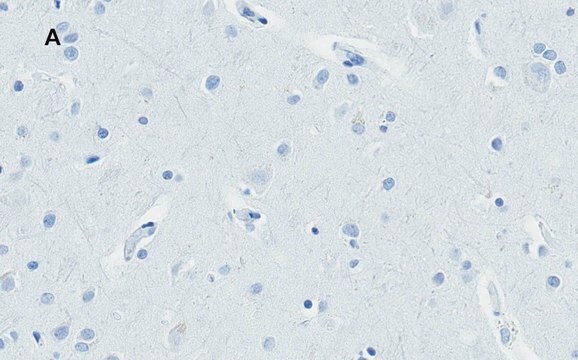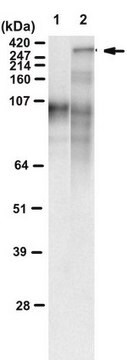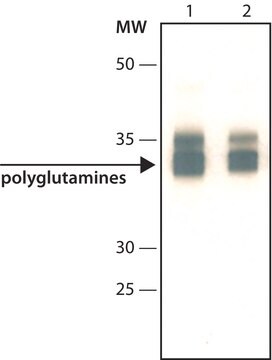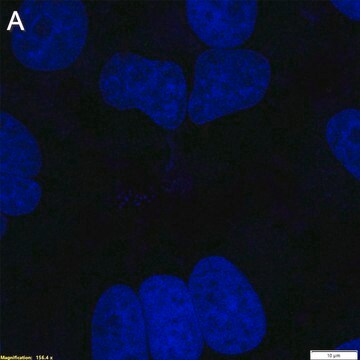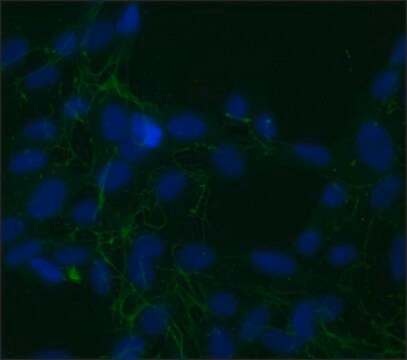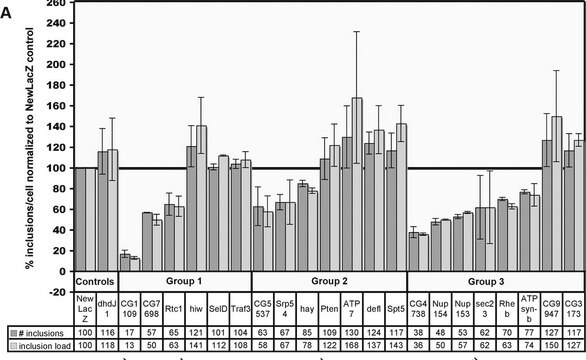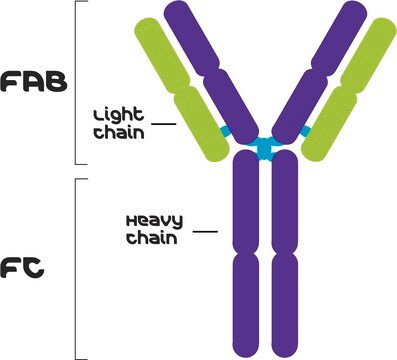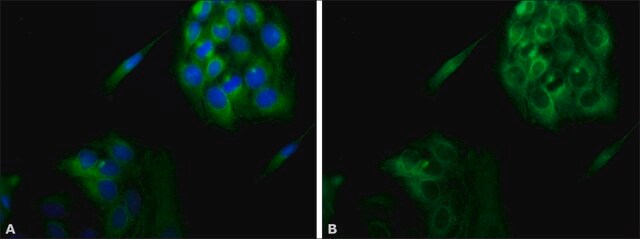추천 제품
생물학적 소스
mouse
Quality Level
항체 형태
ascites fluid
항체 생산 유형
primary antibodies
클론
1HU-4C8, monoclonal
종 반응성
rat, rabbit
종 반응성(상동성에 의해 예측)
mouse, human, hamster, monkey
제조업체/상표
Chemicon®
기술
ELISA: suitable
immunocytochemistry: suitable
immunohistochemistry: suitable (paraffin)
immunoprecipitation (IP): suitable
western blot: suitable
동형
IgG1κ
NCBI 수납 번호
UniProt 수납 번호
배송 상태
dry ice
타겟 번역 후 변형
unmodified
유전자 정보
human ... HTT(3064) , SLC6A4(6532)
일반 설명
Huntington disease (HD) is a hereditary, progressive, neurodegenerative ailment characterized by personality changes, motor impairment and subcortical dementia. The molecular basis of the disease involves the expansion of the trinucleotide CAG, coding for polyglutamine in the first exon of a chromosome four gene (4p16.3), which normally produces a widely expressed 3136 a.a. (~350 kDa) protein huntingtin with unclear function. The protein is found in the perinuclear region along with microtubules, and in the centrosomal region along with gamma-tubulin. Huntingtin is necessary for neuronal survival and is involved in synaptic vesicle trafficking, microtubule binding and may also have a role in apoptosis. In the HD condition, neuronal cells with the mutant form of huntingtin possess intranuclear aggregations of the N-terminal fragment, causing damaging inclusions in perinuclear locations and striatal neuron cell death. Wild-type huntington and anti-huntingtin reduce aggregation and cellular toxicity of the mutant huntingtin form in mammalian cell models of HD. Huntingtin is known to interact with GAPDH, HAP-1, SP1 and TAFII130.
특이성
Huntingtin Protein. No detectable cross reactivity to other proteins by Western blot.
면역원
Epitope: a.a. 181-810
Huntingtin fragment from a.a. 181 to 810 as a fusion protein.
애플리케이션
Anti-Huntingtin Protein Antibody, a.a. 181-810, clone 1HU-4C8 is an antibody against Huntingtin Protein for use in ELISA, IC, IH(P), IP & WB.
ELISA:
A 1:500-1:5,000 dilution of a previous lot was used on ELISA.
Immunohistochemistry:
A 1:500-1:5,000 dilution from a previous lot was used on frozen and microwave oven treated paraffin sections (human tissue).
Immunocytochemistry:
1:500-1:5,000 on a previous lot was used on transfected cells.
Immunoprecipitation:
A 1:500-1:5,000 dilution of a previous lot was used on immunoprecipitation.
Western blot:
1:500-1:5,000. Should detect a band migrating at approximately 350-400 kDa by Western blot (Nature Genetics 10:104-110.).
Optimal working dilutions must be determined by the end user.
A 1:500-1:5,000 dilution of a previous lot was used on ELISA.
Immunohistochemistry:
A 1:500-1:5,000 dilution from a previous lot was used on frozen and microwave oven treated paraffin sections (human tissue).
Immunocytochemistry:
1:500-1:5,000 on a previous lot was used on transfected cells.
Immunoprecipitation:
A 1:500-1:5,000 dilution of a previous lot was used on immunoprecipitation.
Western blot:
1:500-1:5,000. Should detect a band migrating at approximately 350-400 kDa by Western blot (Nature Genetics 10:104-110.).
Optimal working dilutions must be determined by the end user.
Research Category
Neuroscience
Neuroscience
Research Sub Category
Neurodegenerative Diseases
Neurodegenerative Diseases
품질
Routinely evaluated by Western Blot on rat brain lysates.
Western Blot Analysis:
1:1000 dilution of this lot detected huntingtin protein on 10 μg of rat brain lysates.
Western Blot Analysis:
1:1000 dilution of this lot detected huntingtin protein on 10 μg of rat brain lysates.
표적 설명
~ 350-400 kDa
물리적 형태
Ascites mouse monoclonal IgG1κ liquid containing no preservative
Unpurified
저장 및 안정성
Stable for 1 year at -20ºC in undiluted aliquots from date of receipt.
Handling Recommendations: Upon receipt, and prior to removing the cap, centrifuge the vial and gently mix the solution. Aliquot into microcentrifuge tubes and store at -20°C. Avoid repeated freeze/thaw cycles, which may damage IgG and affect product performance.
Handling Recommendations: Upon receipt, and prior to removing the cap, centrifuge the vial and gently mix the solution. Aliquot into microcentrifuge tubes and store at -20°C. Avoid repeated freeze/thaw cycles, which may damage IgG and affect product performance.
분석 메모
Control
Normal human cerebral cortex lysate
Normal human cerebral cortex lysate
기타 정보
Concentration: Please refer to the Certificate of Analysis for the lot-specific concentration.
법적 정보
CHEMICON is a registered trademark of Merck KGaA, Darmstadt, Germany
면책조항
Unless otherwise stated in our catalog or other company documentation accompanying the product(s), our products are intended for research use only and are not to be used for any other purpose, which includes but is not limited to, unauthorized commercial uses, in vitro diagnostic uses, ex vivo or in vivo therapeutic uses or any type of consumption or application to humans or animals.
적합한 제품을 찾을 수 없으신가요?
당사의 제품 선택기 도구.을(를) 시도해 보세요.
Storage Class Code
12 - Non Combustible Liquids
WGK
WGK 2
Flash Point (°F)
Not applicable
Flash Point (°C)
Not applicable
시험 성적서(COA)
제품의 로트/배치 번호를 입력하여 시험 성적서(COA)을 검색하십시오. 로트 및 배치 번호는 제품 라벨에 있는 ‘로트’ 또는 ‘배치’라는 용어 뒤에서 찾을 수 있습니다.
Tailor-made RNAi knockdown against triplet repeat disease-causing alleles.
Takahashi, M; Watanabe, S; Murata, M; Furuya, H; Kanazawa, I; Wada, K; Hohjoh, H
Proceedings of the National Academy of Sciences of the USA null
C L Benn et al.
Neuroscience, 147(2), 354-372 (2007-06-05)
A yeast artificial chromosome (YAC) mouse model of Huntington's disease (YAC128) develops motor abnormalities, age-dependent striatal atrophy and neuronal loss. Alteration of neurotransmitter receptors, particularly glutamate and dopamine receptors, is a pathological hallmark of Huntington's disease. We therefore analyzed neurotransmitter
Co-localization of brain-derived neurotrophic factor (BDNF) and wild-type huntingtin in normal and quinolinic acid-lesioned rat brain
Fusco, F.R. et al.
The European Journal of Neuroscience, 18, 1-10 (2003)
L Cai et al.
Neuroscience, 181, 196-205 (2011-03-15)
The transcription regulator, neuron-restrictive silencer factor (NRSF), also known as repressor element-1 silencing transcription factor (REST), plays an important role in neurogenesis and various neuronal diseases such as ischaemia, epilepsy, and Huntington's disease. In these disease processes, neuronal loss is
M O Hebb et al.
FASEB journal : official publication of the Federation of American Societies for Experimental Biology, 13(9), 1099-1106 (1999-05-25)
Huntington's disease (HD) is one of a number of neurodegenerative disorders caused by expansion of polyglutamine-encoding CAG repeats within specific genes. Huntingtin, the protein product of the HD gene, is widely expressed in neural and nonneural human and rodent tissue.
자사의 과학자팀은 생명 과학, 재료 과학, 화학 합성, 크로마토그래피, 분석 및 기타 많은 영역을 포함한 모든 과학 분야에 경험이 있습니다..
고객지원팀으로 연락바랍니다.